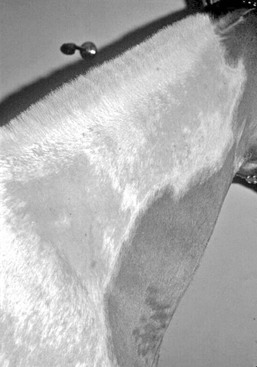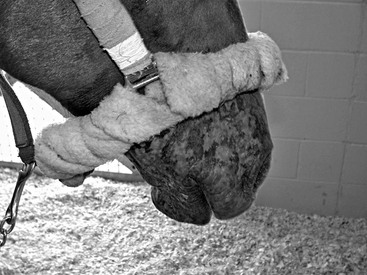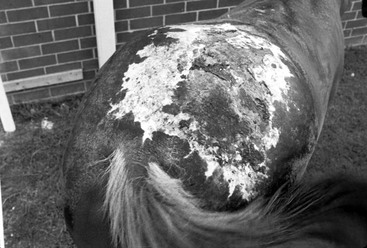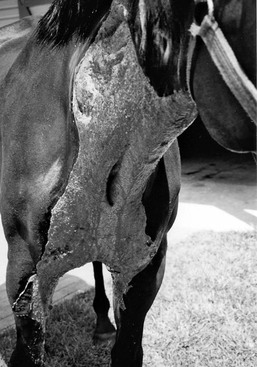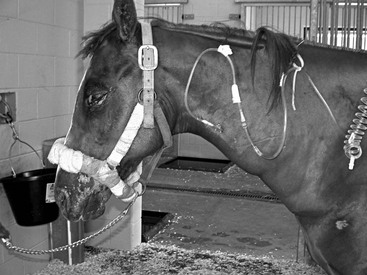R. Reid Hanson, Elizabeth J. Barrett
Burn Injuries
Burn injuries are a relatively rare occurrence in horses. Barn fires are responsible for the most severe burn injuries in horses, and often these injuries involve large areas of skin. Other causes of thermal injuries include brush fires, friction injuries from rope, electrical burns, sunburn, firing and branding injuries, or chemical burns caused by caustic substances.
The prognosis for horses with burn injury is proportional to the extent of the burn, the severity of the burn, the structures involved, the extent of any complications that may develop as a result of the burn, and the care and treatment available to the animal. A horse may survive the initial thermal injury but suffer loss of athletic function caused by either scarring that prevents proper movement of joints or permanent smoke damage that injures the lower airway. Before proceeding with treatment of an extensive burn injury, the examiner should thoroughly evaluate each body system. Owners need to be clearly informed of the prognosis, cost of protracted medical therapy, and potential complications.
Classification of Burns
Burns are classified into degrees on the basis of depth of the injury. First-degree burns involve only the superficial layers of the epidermis. They are painful and cause localized erythema, edema, and desquamation of the superficial layers of the skin. First-degree burns typically heal well, without scar formation (Figure 11-1).
Second-degree burns are subdivided into categories of superficial or deep burns. In superficial burns, only a few cells of the basal germinal layer of the epidermis are damaged, and pain and tactile receptors remain intact. Because most of the basal layers are undamaged, healing proceeds rapidly, and the burns heal within 14 days with minimal scarring (Figure 11-2). Deep second-degree burns involve all layers of the epidermis and result in erythema, edema at the epidermal–dermal junction, epidermal necrosis, and eschar formation. These burns damage the pain receptors in the basal layers of the epidermis, resulting in minimal pain. Deep second-degree burns typically necessitate skin grafts to prevent extensive scarring.
Third-degree burns involve all layers of the epidermis and dermis. Affected areas range from white to black in color and are nonpainful. These burns cause marked fluid loss, significant cellular response at the burn junction, and eschar formation. Complications are common and include shock, wound infection, septicemia, and bacteremia. The healing process is protracted and is preceded by epithelial migration from the wound edges. Skin grafts may improve outcome (Figure 11-3). Fourth-degree burns involve all layers of the skin and the underlying muscle, fascia, ligaments, and bone (Figure 11-4).
Burn injuries are further described by their extent and severity. The extent of a burn relates to the area of body surface damaged by the burn. Severity refers to the maximal temperature to which the tissue is exposed and the duration of that overheating. The rule of nine is used in human medicine to estimate the total body surface area involved. Each arm represents 9%, each leg 18%, the head and neck 9%, the thorax 18%, and the abdomen 18% of body surface area. Although no specific guidelines exist for large animals, euthanasia should be recommended for horses with deep partial-thickness to full-thickness burns involving 30% to 50% of the total body surface area. Horses with burns involving greater than 10% to 15% of body surface area should be given a poor prognosis. A final decision on prognosis and the extent of damage should be delayed for 48 to 72 hours. Because heat dissipates slowly from tissue, it may take time for the full extent of a burn injury to become apparent (Figures 11-5 and 11-6).
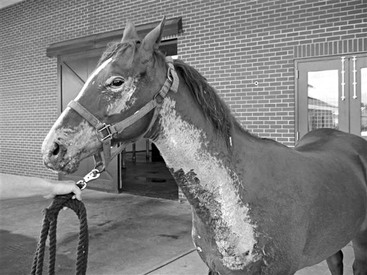
Stay updated, free articles. Join our Telegram channel

Full access? Get Clinical Tree


